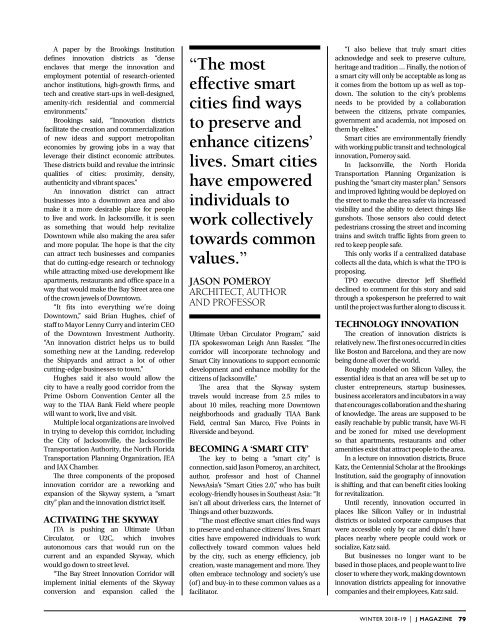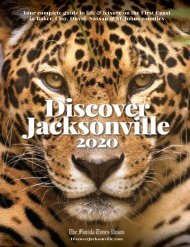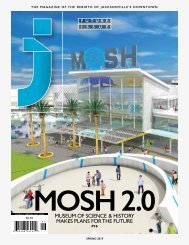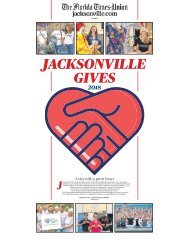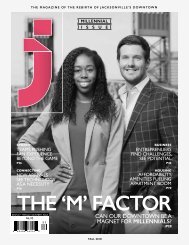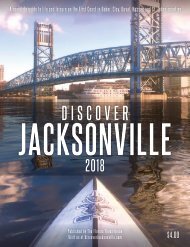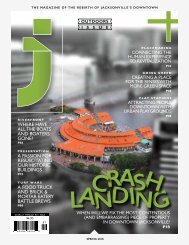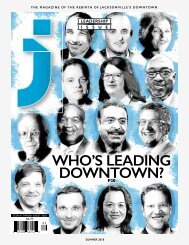J Magazine Winter 2018
You also want an ePaper? Increase the reach of your titles
YUMPU automatically turns print PDFs into web optimized ePapers that Google loves.
A paper by the Brookings Institution<br />
defines innovation districts as “dense<br />
enclaves that merge the innovation and<br />
employment potential of research-oriented<br />
anchor institutions, high-growth firms, and<br />
tech and creative start-ups in well-designed,<br />
amenity-rich residential and commercial<br />
environments.”<br />
Brookings said, “Innovation districts<br />
facilitate the creation and commercialization<br />
of new ideas and support metropolitan<br />
economies by growing jobs in a way that<br />
leverage their distinct economic attributes.<br />
These districts build and revalue the intrinsic<br />
qualities of cities: proximity, density,<br />
authenticity and vibrant spaces.”<br />
An innovation district can attract<br />
businesses into a downtown area and also<br />
make it a more desirable place for people<br />
to live and work. In Jacksonville, it is seen<br />
as something that would help revitalize<br />
Downtown while also making the area safer<br />
and more popular. The hope is that the city<br />
can attract tech businesses and companies<br />
that do cutting-edge research or technology<br />
while attracting mixed-use development like<br />
apartments, restaurants and office space in a<br />
way that would make the Bay Street area one<br />
of the crown jewels of Downtown.<br />
“It fits into everything we’re doing<br />
Downtown,” said Brian Hughes, chief of<br />
staff to Mayor Lenny Curry and interim CEO<br />
of the Downtown Investment Authority.<br />
“An innovation district helps us to build<br />
something new at the Landing, redevelop<br />
the Shipyards and attract a lot of other<br />
cutting-edge businesses to town.”<br />
Hughes said it also would allow the<br />
city to have a really good corridor from the<br />
Prime Osborn Convention Center all the<br />
way to the TIAA Bank Field where people<br />
will want to work, live and visit.<br />
Multiple local organizations are involved<br />
in trying to develop this corridor, including<br />
the City of Jacksonville, the Jacksonville<br />
Transportation Authority, the North Florida<br />
Transportation Planning Organization, JEA<br />
and JAX Chamber.<br />
The three components of the proposed<br />
innovation corridor are a reworking and<br />
expansion of the Skyway system, a “smart<br />
city” plan and the innovation district itself.<br />
ACTIVATING the Skyway<br />
JTA is pushing an Ultimate Urban<br />
Circulator, or U2C, which involves<br />
autonomous cars that would run on the<br />
current and an expanded Skyway, which<br />
would go down to street level.<br />
“The Bay Street Innovation Corridor will<br />
implement initial elements of the Skyway<br />
conversion and expansion called the<br />
“The most<br />
effective smart<br />
cities find ways<br />
to preserve and<br />
enhance citizens’<br />
lives. Smart cities<br />
have empowered<br />
individuals to<br />
work collectively<br />
towards common<br />
values.”<br />
JASON POMEROY<br />
ARCHITECT, AUTHOR<br />
AND PROFESSOR<br />
Ultimate Urban Circulator Program,” said<br />
JTA spokeswoman Leigh Ann Rassler. “The<br />
corridor will incorporate technology and<br />
Smart City innovations to support economic<br />
development and enhance mobility for the<br />
citizens of Jacksonville.”<br />
The area that the Skyway system<br />
travels would increase from 2.5 miles to<br />
about 10 miles, reaching more Downtown<br />
neighborhoods and gradually TIAA Bank<br />
Field, central San Marco, Five Points in<br />
Riverside and beyond.<br />
BECOMING A ‘smart city’<br />
The key to being a “smart city” is<br />
connection, said Jason Pomeroy, an architect,<br />
author, professor and host of Channel<br />
NewsAsia’s “Smart Cities 2.0,” who has built<br />
ecology-friendly houses in Southeast Asia: “It<br />
isn’t all about driverless cars, the Internet of<br />
Things and other buzzwords.<br />
“The most effective smart cities find ways<br />
to preserve and enhance citizens’ lives. Smart<br />
cities have empowered individuals to work<br />
collectively toward common values held<br />
by the city, such as energy efficiency, job<br />
creation, waste management and more. They<br />
often embrace technology and society’s use<br />
(of) and buy-in to these common values as a<br />
facilitator.<br />
“I also believe that truly smart cities<br />
acknowledge and seek to preserve culture,<br />
heritage and tradition … Finally, the notion of<br />
a smart city will only be acceptable as long as<br />
it comes from the bottom up as well as topdown.<br />
The solution to the city’s problems<br />
needs to be provided by a collaboration<br />
between the citizens, private companies,<br />
government and academia, not imposed on<br />
them by elites.”<br />
Smart cities are environmentally friendly<br />
with working public transit and technological<br />
innovation, Pomeroy said.<br />
In Jacksonville, the North Florida<br />
Transportation Planning Organization is<br />
pushing the “smart city master plan.” Sensors<br />
and improved lighting would be deployed on<br />
the street to make the area safer via increased<br />
visibility and the ability to detect things like<br />
gunshots. Those sensors also could detect<br />
pedestrians crossing the street and incoming<br />
trains and switch traffic lights from green to<br />
red to keep people safe.<br />
This only works if a centralized database<br />
collects all the data, which is what the TPO is<br />
proposing.<br />
TPO executive director Jeff Sheffield<br />
declined to comment for this story and said<br />
through a spokesperson he preferred to wait<br />
until the project was further along to discuss it.<br />
Technology innovation<br />
The creation of innovation districts is<br />
relatively new. The first ones occurred in cities<br />
like Boston and Barcelona, and they are now<br />
being done all over the world.<br />
Roughly modeled on Silicon Valley, the<br />
essential idea is that an area will be set up to<br />
cluster entrepreneurs, startup businesses,<br />
business accelerators and incubators in a way<br />
that encourages collaboration and the sharing<br />
of knowledge. The areas are supposed to be<br />
easily reachable by public transit, have Wi-Fi<br />
and be zoned for mixed use development<br />
so that apartments, restaurants and other<br />
amenities exist that attract people to the area.<br />
In a lecture on innovation districts, Bruce<br />
Katz, the Centennial Scholar at the Brookings<br />
Institution, said the geography of innovation<br />
is shifting, and that can benefit cities looking<br />
for revitalization.<br />
Until recently, innovation occurred in<br />
places like Silicon Valley or in industrial<br />
districts or isolated corporate campuses that<br />
were accessible only by car and didn’t have<br />
places nearby where people could work or<br />
socialize, Katz said.<br />
But businesses no longer want to be<br />
based in those places, and people want to live<br />
closer to where they work, making downtown<br />
innovation districts appealing for innovative<br />
companies and their employees, Katz said.<br />
WINTER <strong>2018</strong>-19 | J MAGAZINE 79


